A clearer view of mental disorders
The science of brain scanning may be on the brink of revolutionizing the intuitive art of psychiatry, one of the few areas of medicine in which a doctor’s educated guess is still the most common route to a diagnosis.
Brain scanning is still too young a science to be used for routine diagnosis of common psychiatric ills. It is already proving invaluable, however, in helping psychiatrists understand the fundamental abnormalities of a wide range of psychiatric disorders, including obsessive compulsive disorder, schizophrenia, anxiety and depression.
Obsessive-compulsive disorder, or OCD, for instance, which strikes roughly 8 million Americans, is a potentially disabling condition in which recurrent fears, images or impulses cause severe anxiety and drive people to repetitive behaviors: compulsive hand-washing, arranging or hoarding, for example.
Researchers at UCLA are experimenting with PET (positron emission tomography) scanning to predict how well patients with OCD or major depression will respond to the antidepressant drug Paxil. (In PET scans, patients are given a radioactive form of the sugar glucose; the color-coded images show, in real time, which areas of the brain are using the most glucose and are working hardest.)
Marc Pincus, who is a participant in the UCLA study, suffered from a compulsive disorder in which he used to awaken at night and feel he had to turn his head toward the clock exactly 19 times (once for each family member) within one minute to protect them from harm. “If, by chance, the clock changed, I had to start again,” said the 41-year-old office manager. “So I didn’t get a lot of sleep.” Just as Pincus’ initial PET scan predicted, he responded well to treatment with Paxil.
Dr. Sanjaya Saxena, an associate professor at the UCLA Neuropsychiatric Institute, says that PET scans have “the potential to be used for identifying patterns of brain activity that predict response” to therapy for both OCD and depression. That’s the case despite the fact that the scans confirmed that the underlying brain abnormalities in OCD and depression are different.
At Massachusetts General Hospital in Boston, Dr. Scott Rauch, director of psychiatric neuro-imaging, has long been using PET and other scans in psychiatric illnesses. In OCD, he and his colleagues scan patients first, while they are resting, then they touch them with feared objects that induce obsessions.
“You see the circuitry light up,” says Rauch, noting that the abnormal brain circuits involve nerve pathways from the orbitofrontal cortex (behind the eyes) to the caudate nucleus (part of the basal ganglia) and thalamus, which lie deep within the brain.
Rauch and his colleagues have also shown that abnormal neural activity in the anterior cingulate portion of the OCD pathway can predict how well people with severe, intractable OCD respond to surgery in which doctors interrupt the pathways through tiny cuts.
Armed with patients’ scans, brain surgeons are trying a different approach: implanting permanent electrodes (brain pacemakers) into the abnormal brain tissue to modulate the abnormal electrical activity. This technique, called deep brain stimulation, already is being used to treat Parkinson’s disease.
More than 15 patients with severe OCD have received the implants from doctors in a multi-center study based at the Cleveland Clinic in Ohio, Butler Hospital in Providence, R.I., and the University of Leuven in Belgium. The electrodes, made by Medtronic Inc., can be turned up or down by the doctor, making the procedure reversible, unlike traditional neurosurgery.
Elsewhere, researchers are using various scans to study other psychiatric afflictions. At the National Institute of Mental Health, researchers have used MRI scans to study attention deficit hyperactivity disorder, or ADHD, in children. (In magnetic resonance imaging, a magnet induces chemicals in the body to emit characteristic radio signals. These signals are converted into 3-D images that show the anatomical structure of the brain. No radioactive drugs are needed.) They found the brains of children with ADHD to be 3% to 4% smaller than those of children without the disorder.
Other researchers are using a variant of MRI called fMRI, or functional MRI, to study brain abnormalities in schizophrenia and other disorders. (Functional MRI provides a real-time image of the brain’s functions, not just structure, by tracking blood flow.)
At Johns Hopkins University in Baltimore, Dr. Rudolf Hoehn-Saric, a professor emeritus of psychiatry, is using fMRI to compare the brains of normal and anxious people. In tests involving listening to recordings of personal worries, people with generalized anxiety disorder, his research shows, have increases in activation in parts of the prefrontal cortex (the thinking part of the brain) and in parts of the emotional brain, or limbic system, including the hippocampus. But after seven weeks on the medication Celexa, an antidepressant, the patients’ scans improved considerably, says Hoehn-Saric. In fact, many of the drugs, like Celexa, that were originally designed to combat depression also seem to work for anxiety, which raises a question the imaging scientists haven’t quite answered yet.
“We know that anxiety and depression, while distinct syndromes, have certain common clinical features and both respond to similar drugs,” says Dr. Helen Mayberg, chair of neuropsychiatry at the Rotman Research Institute at the University of Toronto. “Interestingly, when we get to scanning, we can see at the brain level what might account for some of these similarities and differences.”
Brain scans may never be a substitute for intuitive guesswork by a good psychiatrist. Nor should they. But researchers believe they will be increasingly useful in helping doctors figure out which patients with severe psychiatric illnesses are most likely to respond to treatments.






